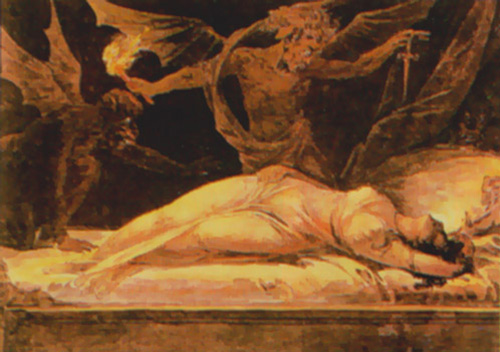Incubus
An incubus is a mythological male night spirit who lies upon sleeping women in order to engage in sexual activity with them. As noted in an earlier blog, the female counterpart of the incubus is a succubus who takes the form of a woman in order to seduce men, also through sexual activity. Salacious tales of incubi and succubi have been told for many centuries in most cultures. Some traditions hold that repeated sexual activity with an incubus or succubus may result in the deterioration of health, mental state, or even death. “Incubus,” Wikipedia, accessed 20 March 2019, https://en.wikipedia.org/wiki/Incubus. The concept of the incubus morphed into the Piren. The role of the Piren also changed from a demon to a seducer. Similarly the succubus morphed into the Siren and her role changed from a demon to a seductress. All became topics for the visual artist.
Figure B-1 shows a painting by Charles Walker (1880) of an incubus portrayed as a demon having intimacy with a woman in order to steal her energy and bewitch her to adhere to witchcraft.

Figure B-1. Incubus, Charles Walker, 1870.
Incubus, colored aquatint, 1870. Walker, Charles: The encyclopedia of secret knowledge. [S.I.]: Limited Editions, 1995
This was a common belief during the Middle and Modern Ages. St. Augustine touched on the topic in De Civitate Dei (The City of God). He said, “There were too many alleged attacks by incubi to deny them. It was said that incubi, have often made wicked assaults upon women”. Saint Augustine, The City of God, trans Marcus Dods (Kansas: Digireads Publishing, 2017) p 4.
One of the earliest mentions of an incubus was from Mesopotamia, ca. 2400 BC, where the hero was listed as Lilu. Raphael Patai, The Hebrew Goddess (Detroit: Wayne State University Press, 1967), p. 221. ISBN 978-0-8143-2271-0. It is said that Lilu disturbs and seduces women in their sleep, while Lilitu, a female demon, appears to men in their erotic dreams. Siegmund Hurwitz, Lilith: The First Eve (Einsiedeln, Switzerland: Daimon Verlag, 1992) ed Robert Hinshaw, trans Gela Jacobson, pp 262 ISBN 3-85630-522-X
The Trauco, according to the traditional mythology of the Chiloé Province of Chile, is a dwarf who lulls nubile young women and seduces them producing unwanted pregnancies. His image appeared on a Chilean postage stamp, Figure B-2.

Figure B-2. El Trauco. Postage Stamp from Chile.
After Casa de Moneda de Chile S.A. 2012
Researchers believe these myths were created to explain pregnancies in women who never left their houses unescorted. In many of these myths, it appears that they are used to cover up unwanted pregnancy or sexual assault. Siegmund Hurwitz, Lilith: The First Eve (Einsiedeln, Switzerland: Daimon Verlag, 1992) ed Robert Hinshaw, trans Gela Jacobson, pp 262 ISBN 3-85630-522-X. Some things have not changed over the centuries.
In the tale about Lilith in a previous blog we heard little of what Lilith thought of Adam. We do not get her side of the story. It would be interesting to hear what Lilith had to say. Adam might have been an incubus or a Piren. A man recorded the tale.
There is a need for a level historical field on which women also write and record history or folklore. We need more old wives tales, truthful wife tales. In fact Eve may have come before Adam. Thanks for modern goddesses, at least they are heard and have an influence.